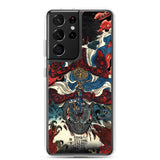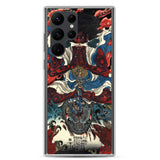'Kidomaru' by Utagawa Kuniyoshi, ca. 1840s. This image is also available on:
Kidomaru is an 'oni' (loosely translated, 'demon' or 'ogre') from Japanese folklore. The main source for stories concerning him is the Kokon Chomonju, a collection of Japanese folktales compiled around 1254 which contains stories dating back to the 8th century. Kuniyoshi was most likely inspired by an 1806 work by the novelist Takizawa (Kyokutei) Bakin.
According to the Kokon Chomonju, Kidomaru was the son of a human woman who was kidnapped by the oni Shuten-doji. After Shuten-doji was decapitated by the hero Minamoto Raiko (an act which did not stop Shuten-doji trying to take a bite out of Raiko), the woman realised she was pregnant. When she gave birth, the baby already had teeth, and by the age of seven or eight Kidomaru was already able to throw a rock hard enough to kill a wild boar.
Kidomaru mostly appears in legends about Minamoto Raiko (a real historical figure, also known as Minamoto no Yorimitsu), as an antagonist trying to avenge his father's death. In the Kokon Chomonju, Yorimitsu and his brother Yorinobu try to bind Kidomaru with chains, but his strength allows him to break them easily. Kidomaru then tries to ambush Yorimitsu by killing a cow near a temple where Yorimitsu is coming to pray, and hiding inside it's body. In Bakin's work ('The Strange Tale of the Deaths of the Four Heavenly Guardians'), Kidomaru learns magic from the tengu (powerful bird monsters, pictured at the bottom of the print), and uses it to summon a giant serpent to battle bandit chief Hakamadare Yasusuke.
Product Details:
Samsung Phone Case, available for 13 different variants.
FREE SHIPPING
Average Delivery Time: 7 - 11 working days
• Solid polycarbonate back
• 0.02″ (0.5 mm) raised bezel
• See-through sides
• Wireless charging compatible
• Easy to take on and off


























